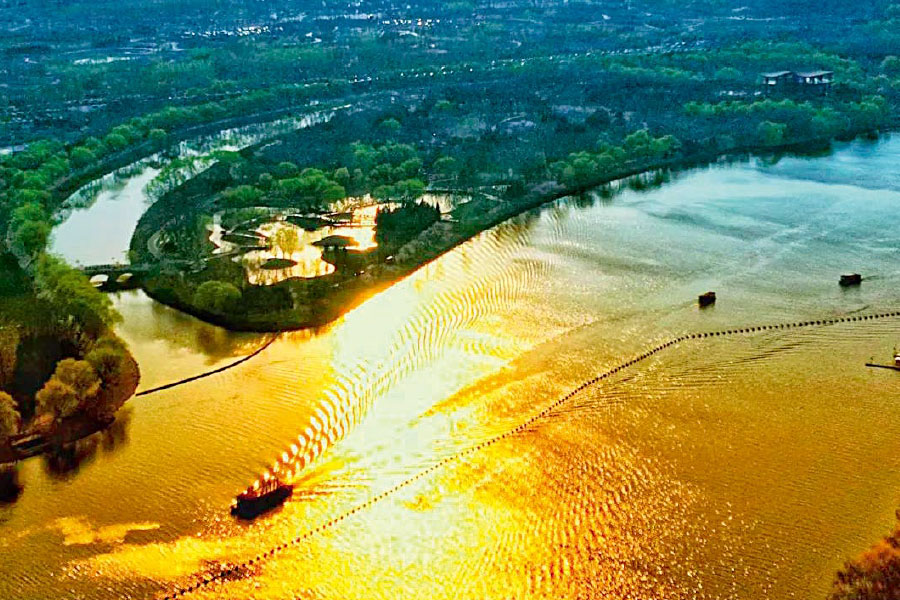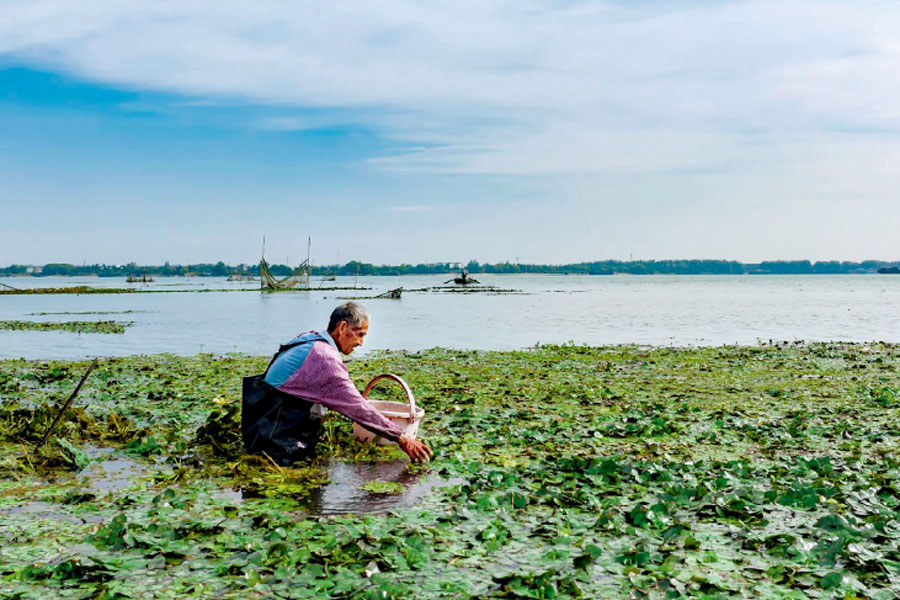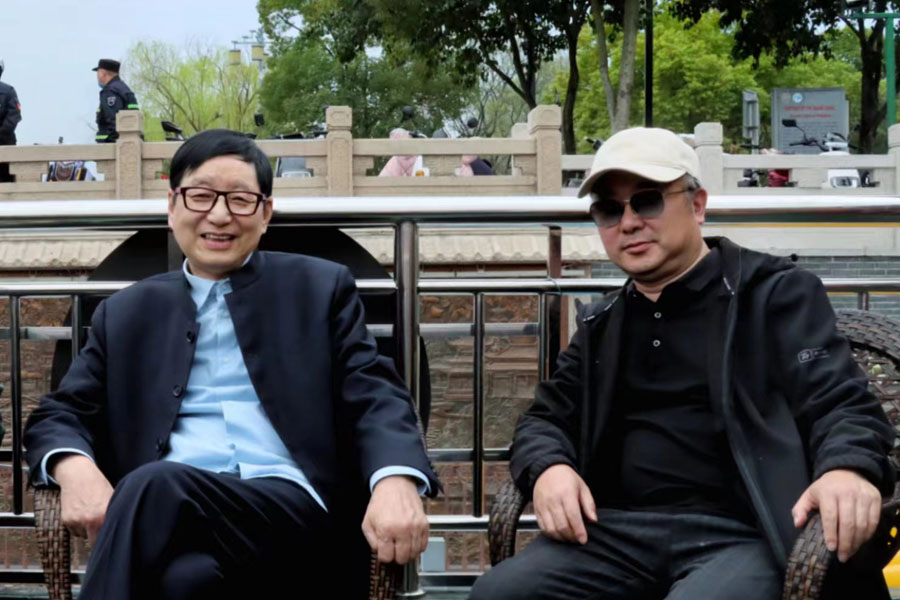My Affection for the Grand Canal

I spent most of my childhood at my grandparents’ house near a river called Tongyang that flows westward to Yangzhou, a city of poetic beauty in eastern China. From a very young age, I had dreamed of taking a boat to Yangzhou. My simple pleasure was sitting on a small stool by the riverbank to watch boats of all sizes come and go. When a large boat passed, the waves it created would elicit laughter and gasps from housewives washing clothes and cleaning rice by the river. The most exciting moments were when I occasionally saw cormorants pulling fish out of the river, which would attract a crowd of onlookers, young and old alike. When the water levels fell, I would sometimes see boatmen pulling their boats, their rhythmic chants reverberating all around.
Not until I turned 40 and began researching canals did I learn that the Tongyang River was also known as the Salt-transporting River. It was an ancient canal with a history of over 2,000 years, connecting Yangzhou, Taizhou, and Nantong. Alongside its role transporting salt and grain, providing water for irrigation, and draining floodwater, the canal served as an emotional bond connecting millions of families along its route—my family among them.

Genesis
In 2005, an occasional opportunity brought me into close contact with the Grand Canal for the first time. The postal department was undergoing reforms and seeking to introduce personalized postal products to the public. I was invited to lead a project to create cultural products for Yangzhou, and I decided to explore the theme of the Grand Canal. Yangzhou, the starting point of the Grand Canal, shared the man-made waterway’s history, growth, and decline. Therefore, it is reputed as the “the direct descendant of the Grand Canal.” To create a unique postal album, I began studying the history of the Grand Canal and assessing its current state, which deepened my connection with it.
During my comprehensive survey of the entire Grand Canal, I witnessed firsthand the “decline” of the waterway that had flowed for 2,500 years. The former glory of the Grand Canal had dimmed in many places, with significant damage to historical relics along its banks. Several sections of the canal were impassable and polluted, especially in the northern regions. This motivated a strong urge in me to advocate for the protection of the Grand Canal. In late 2005, three renowned Chinese experts and scholars, later dubbed the “Three Elders of the Grand Canal”—Zheng Xiaoxie, Luo Zhewen, and Zhu Bingren— jointly sent a letter to the mayors of 18 cities along the Grand Canal, proposing to protect the canal as a World Cultural Heritage site. This marked the beginning of efforts to apply for World Heritage status for the Grand Canal. It also solidified my commitment to using the theme of the Grand Canal to create postal products, promote canal culture, and advocate its protection.
In 2007, with the support of the China National Philatelic Corporation, I led the design and issuance of China’s first set of postage albums themed around the Grand Canal, titled “The Ancient Canal: A Thousand Years of Wind.” It received a warm response in China’s philatelic circles and raised awareness on protection of the Grand Canal. On June 22, 2014, the Grand Canal was successfully inscribed on the World Cultural Heritage List, a moment of great satisfaction and excitement for me. From my first intimate encounter with the Grand Canal to my subsequent immersion in its research over the course of more than a decade, I evolved from a complete outsider to the canal into a guardian and promoter of its culture.

The Power of Proposals
After the successful inscription of the Grand Canal as a World Heritage site, what changes occurred in its protection and utilization? As I embarked on another round of comprehensive research, I found that many places along the Grand Canal had focused more on tourism development after the inscription rather than emphasizing protection and inheritance of cultural heritage. Based on my research and analysis, in November 2014, I completed a report titled “Elevating the Grand Canal Economic Belt to a National Strategy,” which urged local governments along the canal to clarify the original purpose of the Grand Canal’s inscription as a World Heritage site, prioritize cultural heritage preservation and the ecological environment of the canal, and prioritize orderly and rational utilization secondarily. I also proposed that national-level efforts be made to protect and utilize the Grand Canal, coordinate the relationships between the economic, cultural, and ecological aspects of the canal, and organically integrate the preservation and inheritance of canal culture with the development of canal tourism and the restoration of its ecology.

In February 2017, after further refinement by the Jiangsu Provincial Committee of the China Democratic League, my report became a key proposal to the National Committee of the Chinese People’s Political Consultative Conference (CPPCC) titled “Suggestions on Elevating the Building of the Grand Canal Economic Belt to a National Strategy.” It stood out among more than 4,000 proposals presented to the CPPCC National Committee that year.
In February 2019, the Outline for the Protection, Inheritance, and Utilization of Grand Canal Culture was officially released. As construction of the Grand Canal Cultural Belt and the Grand Canal National Cultural Park reached a new stage, protection and utilization of the canal has become a “national action.” The Grand Canal, which has flowed for over 2,500 years, is rejuvenating with new vitality.
The author is a member of the World Historic and Cultural Canal Cities Cooperation Organization and the expert advisory committee of the Grand Canal Cultural Belt Construction Research Institute, and executive director of the Grand Canal Research Institute at Yangzhou University.